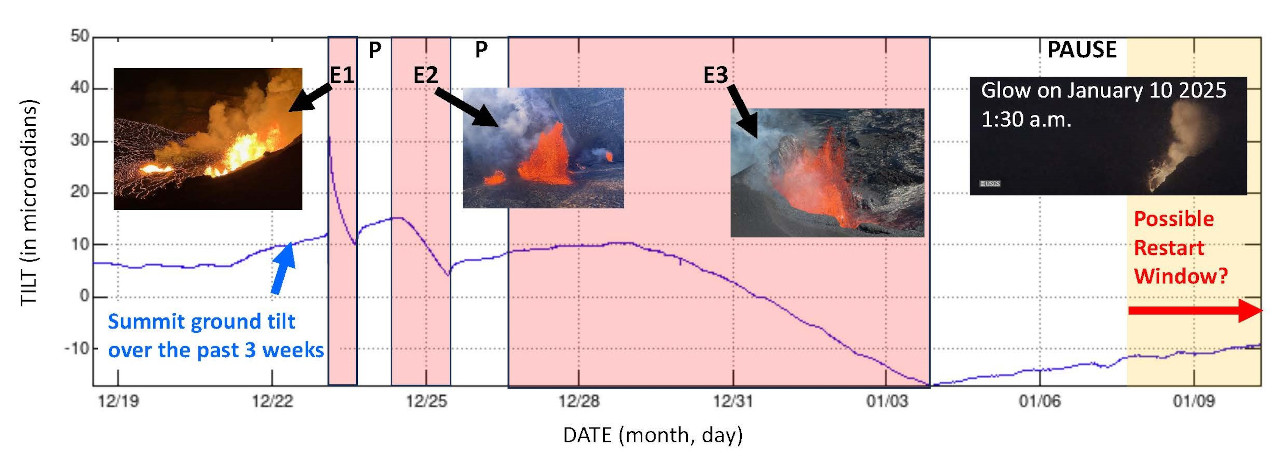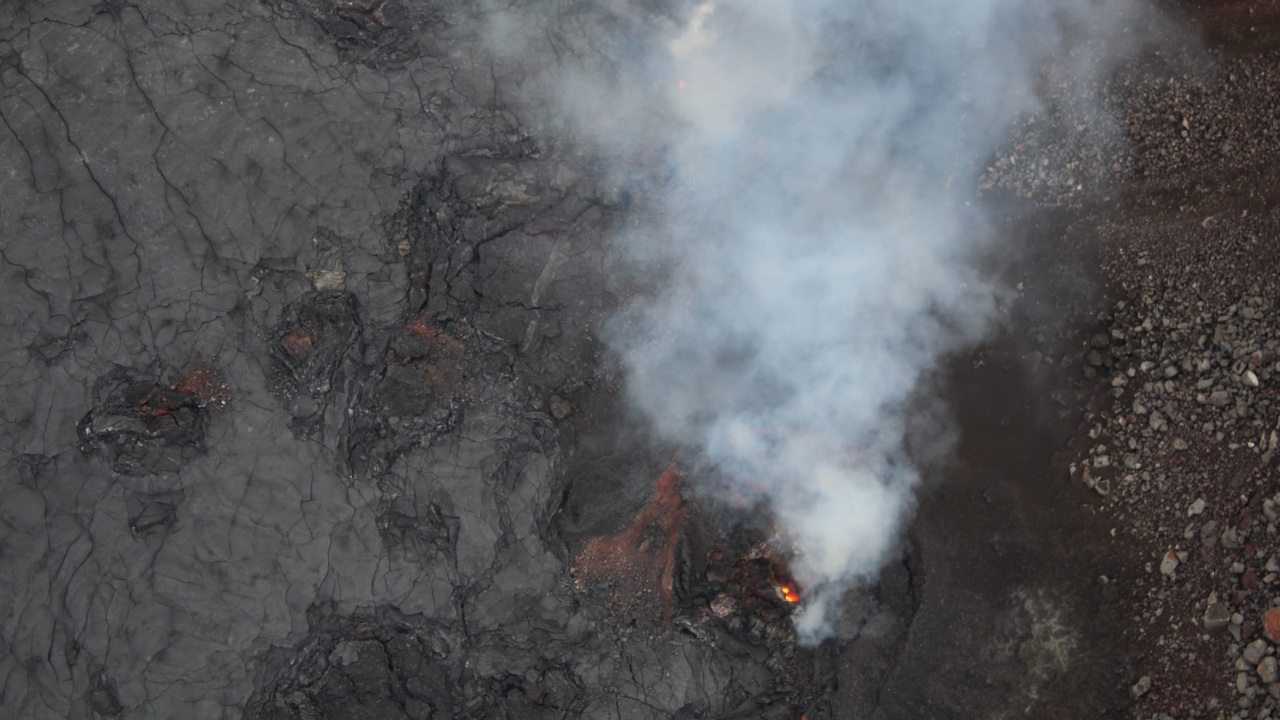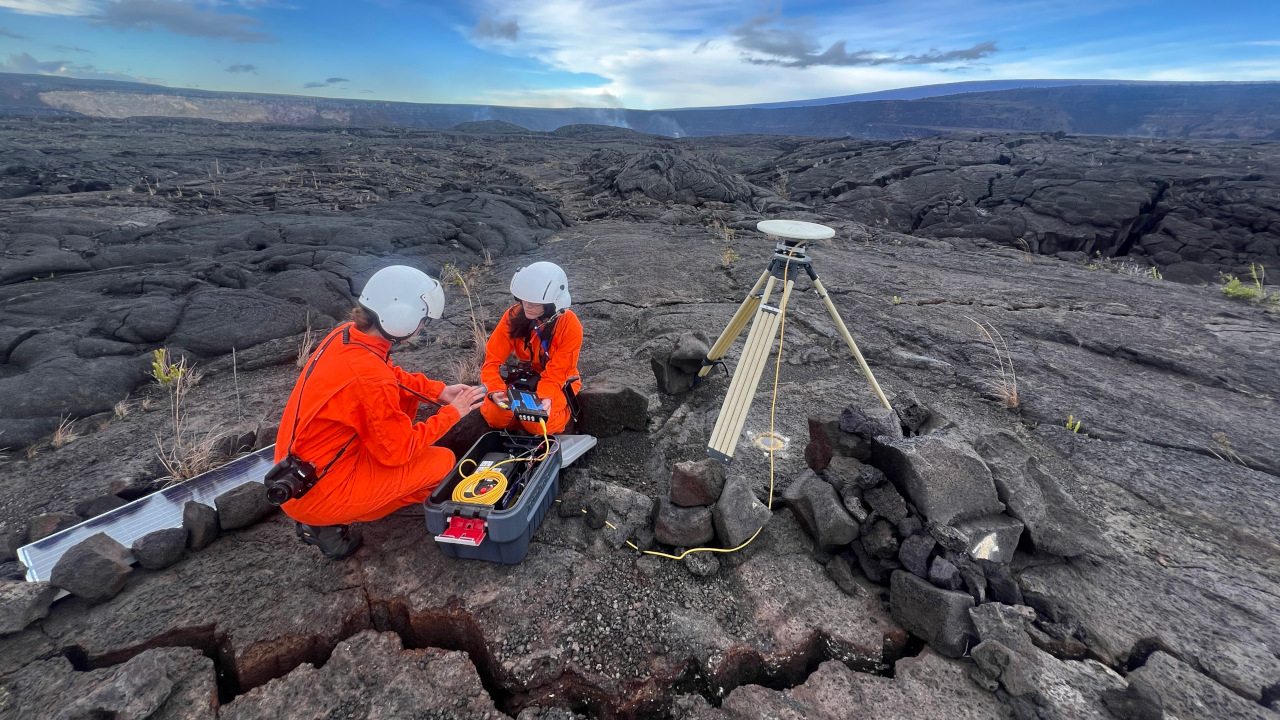(BIVN) – Kīlauea is not erupting, and the USGS Volcano Alert Level remains at WATCH.
A vent created by the latest eruption in December continues to degas and there is a glow visible at the summit location during the night. Scientists believe a new eruptive episode could potentially begin sometime between January 8 and January 13.
From this week’s Volcano Watch article written by U.S. Geological Survey Hawaiian Volcano Observatory scientists and affiliates:
The recent eruption of Kīlauea within Halemaʻumaʻu brought back an eruptive style not seen for many years. The eruption included 3 episodes of lava fountaining separated by pauses in activity. The third pause is ongoing, and USGS Hawaiian Volcano Observatory scientists are reviewing patterns of past eruptions and current monitoring data to forecast what could happen next at Kīlauea.
Episodic eruptions have occurred before on Kīlauea at the start of the 1983 Puʻuʻōʻō and the 1969 Maunaulu eruptions (44 and 12 episodes each) on the middle East Rift Zone, and during the 1959 Kīlauea Iki summit eruption (17 episodes). While the recent Kīlauea summit eruption is currently paused, persistent night glow from the vent and continued strong degassing indicate molten magma is probably within 150–300 feet (50–100 meters) of the surface within the vent.
Sufficient pressure could push magma up to the surface to start another eruptive episode. Fountaining is driven by rapid volume expansion of gas in fresh lava but is commonly preceded by periods of eruption of sluggish degassed flows. Dense degassed material is pushed out of the vent like a cork from a champagne bottle, allowing gas-rich magma to rise rapidly and fountain.
Episodes are marked by the onset of lava fountains and rapid deflation of the source magma chamber. Pauses between fountain episodes are usually accompanied by reinflation of the summit. A new episode begins when the system builds up enough pressure to force magma to the surface again.
The main feature of episodic eruptions is their repeatability, which allows patterns to be identified. Inflation following episodes 1 and 2 of the recent eruption at the summit of Kīlauea resulted in 6 microradians of ground tilt a tiltmeter north of the caldera, near Uēkahuna bluff, indicating the pressure increase required at that time for the eruption to resume.

USGS: “Ground tilt and eruptive episodes associated with Kīlauea summit eruption December 23, 2024, to January 10, 2025. Eruptive episodes are highlighted in red. Fountain Episode 1 (E1) began at 2:20 a.m. HST on December 23, 2024, and continued until 4 p.m. that day (14 hours duration). Fountain Episode 2 (E2) began at 8 a.m. HST on December 24, 2024, and continued until 11 a.m. HST on December 25 (15 hours duration). Fountain Episode 3 (E3) began at 8 a.m. HST on December 26, 2024, and continued until 8:30 p.m. HST on January 3, 2025 (8 and a half days duration). Assuming the eruptive vent(s) remains open, indicated by continued glow and degassing, and inflation rate remains constant, a new episode could potentially begin sometime between January 8 and January 13, when ground tilt at Uēkahuna is expected to reach 12 microradians, about double prior post-fountain tilt increases.”
Following episode 3, Kīlauea has inflated and the 6 microradian level was reached about 4:30 p.m. HST Wednesday, January 8 afternoon (5 days after episode 3 paused on Friday, January 3 at 8:40 p.m. HST). That amount of inflation had been the minimum amount of pressure required previously for this eruption to restart. However, the large deflation that accompanied the prolonged fountaining of episode 3 suggests the system might need more inflation to reach the pressure necessary for eruptive activity to resume.
The longer the vent sits without eruption, the more time magma within the vent has to cool and it could reach a point that the eruption can’t restart. Assuming the vent remains open, indicated by continued glow and degassing, and inflation rate remains constant, a new episode could potentially begin sometime between January 8 and January 13, when ground tilt at Uēkahuna is expected to reach 12 microradians, about double prior post-fountain tilt increases.

USGS: “Telephoto view of eruptive cones from the December 2024 to January 2025 eruption in Kīlauea’s summit. This photo was taken looking down onto the caldera floor during a USGS Hawaiian Volcano Observatory monitoring overflight the morning of January 10, 2025. The north cone that was active during the recent eruption is in the center of the image, and lava glowing from within the vent is visible. The south vent is out of the frame, but a small lava flow is coming out of that vent and visible in the top left portion of the photo.” (USGS photo by H. Winslow)
HVO scientists have been developing tools estimate times of high probabilities of eruptions occurring on Kīlauea for the past several years. Complex models using GPS monitoring data have been created to track when the summit approached pressurization levels similar to previous eruptions.
Models run in October of 2024 indicated that Kīlauea was likely to reach pressurization levels where an eruption could happen between mid-December 2024 and mid-January 2025. This model also relies on the eruption being preceded by increasing numbers of earthquakes in the region where the eruption is most probable.
“Windows” of high probability for new eruptions or new fountaining episodes aren’t true forecasts. A forecast requires knowing what will happen, where it will happen, and most importantly, an accurate estimate of when it will happen. Forecasting when an eruption will happen is the most difficult part but is very important so communities have more time to prepare if needed.
Whenever HVO raises alert levels to ORANGE/WATCH, we are issuing a more precise forecast for a pending eruption or intrusion within minutes to hours near the summit or hours to days further along Kīlauea’s rift zones.
HVO scientists are constantly improving models of volcanic behavior—past, present and future—which allows us to forecast eruption time windows with greater accuracy and longer advance warning. This is an essential part of HVO’s mission to reduce the impacts of volcanic eruptions and communicate the results of our work to emergency managers and the public.


by Big Island Video News7:42 pm
on at
STORY SUMMARY
HAWAIʻI VOLCANOES NATIONAL PARK - Scientists have speculated that a new episode could potentially begin sometime between January 8 and January 13.